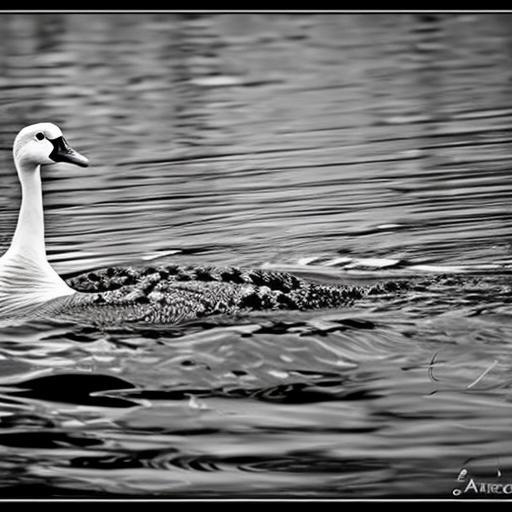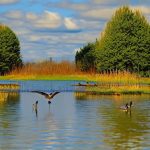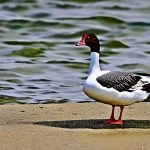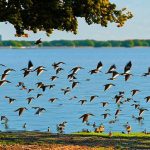Swim rafts are a popular addition to lakes and ponds, providing a fun and relaxing space for swimmers to enjoy the water. However, one common problem that many swim raft owners face is the presence of geese. Geese are attracted to swim rafts for a variety of reasons, including the safety and warmth they provide. While geese may seem harmless, their presence can pose a number of problems for both swimmers and the environment.
When geese make themselves at home on swim rafts, they can quickly become a nuisance. Their droppings can make the surface of the raft slippery and unsightly, making it difficult for swimmers to safely enjoy their time in the water. Additionally, geese can be aggressive and territorial, especially during nesting season. This can create a hostile environment for swimmers and may even lead to physical harm. Furthermore, the droppings left behind by geese can have negative impacts on water quality and the overall ecosystem of the lake or pond.
Key Takeaways
- Geese on swim rafts can be a problem for swimmers.
- Understanding geese behavior can help prevent them from landing on swim rafts.
- Geese on swim rafts can pose a danger to swimmers due to their droppings.
- Building a physical barrier or using visual, audio, or scent deterrents can prevent geese from landing on swim rafts.
- Planting vegetation and maintaining a clean swim raft can also help prevent geese from landing.
Understanding the Behavior of Geese
To effectively address the issue of geese on swim rafts, it is important to understand their behavior and why they are attracted to these structures in the first place. Geese are social animals that prefer to gather in large groups, known as flocks. They are also highly adaptable and can thrive in a variety of environments, including urban areas and bodies of water.
Swim rafts provide an ideal habitat for geese because they offer safety from predators and a warm place to rest. Geese are attracted to the flat surface of swim rafts, which resembles their natural nesting grounds. Additionally, swim rafts often provide easy access to food sources such as algae and aquatic plants.
Geese can also be aggressive and dangerous, especially during nesting season when they are protecting their eggs or young goslings. They may hiss, flap their wings, or even charge at perceived threats. This behavior can be intimidating and potentially harmful to swimmers who come too close to their nesting area.
The Dangers of Geese on Swim Rafts
Having geese on swim rafts can pose a number of dangers for both swimmers and the environment. Firstly, the presence of geese can make the surface of the raft slippery and unsafe for swimmers. Their droppings contain high levels of bacteria, which can lead to infections and other health issues if swimmers come into contact with them.
Furthermore, geese can become aggressive and territorial, especially during nesting season. This can create a hostile environment for swimmers, who may be attacked or injured if they come too close to a nesting goose. Additionally, the droppings left behind by geese can pollute the water and negatively impact the overall ecosystem of the lake or pond. The high levels of nitrogen and phosphorus in goose droppings can lead to excessive algae growth, which can deplete oxygen levels in the water and harm fish and other aquatic organisms.
Prevention Techniques: Building a Physical Barrier
One effective way to prevent geese from accessing swim rafts is by building a physical barrier around the perimeter. This can be done using materials such as netting, fencing, or floating barriers. The benefits of building a physical barrier include creating a physical deterrent that prevents geese from landing on the raft and reducing the risk of slips and falls caused by goose droppings.
Netting is a popular choice for creating a physical barrier around swim rafts. It can be installed above the raft to prevent geese from landing or below the raft to catch droppings before they reach the water. Fencing is another option that can be used to create a barrier around the perimeter of the raft. This can be done using materials such as chicken wire or plastic mesh. Floating barriers, such as inflatable tubes or buoys, can also be used to create a physical barrier that prevents geese from accessing the raft.
Prevention Techniques: Using Visual Deterrents
In addition to physical barriers, visual deterrents can also be effective in keeping geese away from swim rafts. Visual deterrents work by creating an illusion of danger or making the area appear less attractive to geese. There are several types of visual deterrents that can be used, including decoy predators, reflective devices, and scare tape.
Decoy predators, such as plastic owls or coyotes, can be placed on or near the swim raft to create the illusion of a threat. Geese are naturally wary of predators and will avoid areas where they believe there is a risk of being attacked. Reflective devices, such as shiny balloons or strips of aluminum foil, can also be effective in deterring geese. The reflective surfaces create a sense of movement and unpredictability, which makes geese uncomfortable and less likely to land on the raft. Scare tape is another visual deterrent that can be used. It is made of shiny material that flutters in the wind, creating a visual disturbance that scares away geese.
Prevention Techniques: Using Audio Deterrents
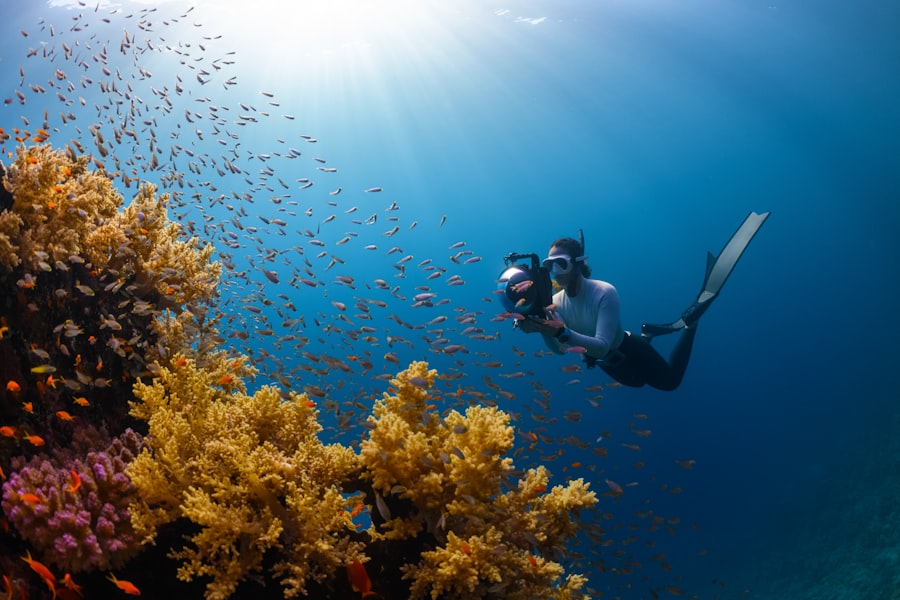
Audio deterrents can also be effective in keeping geese away from swim rafts. These devices emit sounds that are unpleasant or threatening to geese, causing them to avoid the area. There are several types of audio deterrents that can be used, including sonic devices, ultrasonic devices, and predator calls.
Sonic devices emit loud noises or distress calls that are unpleasant to geese. These devices can be programmed to emit different sounds at random intervals to prevent geese from becoming accustomed to them. Ultrasonic devices emit high-frequency sounds that are inaudible to humans but irritating to geese. These devices can be placed on or near the swim raft to create a sonic barrier that geese will avoid. Predator calls, such as recordings of bird distress calls or predator cries, can also be effective in deterring geese. These calls create the illusion of danger and make geese feel unsafe, causing them to leave the area.
Prevention Techniques: Using Scent Deterrents
Scent deterrents can be used to create an unpleasant or unfamiliar scent that repels geese. There are several types of scent deterrents that can be used, including chemical repellents, natural repellents, and essential oils.
Chemical repellents are commercially available products that contain ingredients that are unpleasant to geese. These repellents can be sprayed on or around the swim raft to create a barrier that geese will avoid. Natural repellents, such as garlic or chili pepper, can also be effective in deterring geese. These repellents can be mixed with water and sprayed on the raft or applied directly to the surface. Essential oils, such as peppermint or citrus, can also be used to create a scent deterrent. These oils can be mixed with water and sprayed on or around the swim raft to repel geese.
Natural Prevention Techniques: Planting Vegetation
Planting vegetation around the swim raft can also help deter geese from landing on it. Geese prefer open spaces where they have a clear line of sight and easy access to food sources. By planting tall grasses or shrubs around the perimeter of the raft, you can create a barrier that makes it difficult for geese to land and access the water.
Tall grasses, such as switchgrass or big bluestem, can be planted around the swim raft to create a natural barrier. These grasses provide cover and make it difficult for geese to see the water from a distance. Shrubs, such as juniper or holly, can also be planted to create a dense barrier that geese will avoid. Additionally, planting native aquatic plants, such as water lilies or cattails, can help create a natural habitat that attracts other wildlife and reduces the appeal of the swim raft to geese.
Maintaining a Clean Swim Raft
In addition to implementing prevention techniques, it is important to maintain a clean swim raft to discourage geese from landing and nesting. Regular cleaning and maintenance can help remove any food sources or debris that may attract geese.
To properly clean a swim raft, start by removing any debris or droppings from the surface using a broom or brush. Next, use a mild detergent or cleaning solution to scrub the surface and remove any stains or residue. Rinse the raft thoroughly with clean water and allow it to dry completely before using it again. It is also important to regularly inspect the raft for any signs of damage or wear and repair or replace any damaged parts as needed.
Enjoying a Geese-Free Swim Raft
In conclusion, the presence of geese on swim rafts can pose a number of problems for both swimmers and the environment. However, there are several effective prevention techniques that can be used to keep geese away from swim rafts. Building a physical barrier, using visual deterrents, employing audio deterrents, using scent deterrents, planting vegetation, and maintaining a clean swim raft are all effective strategies for keeping geese at bay.
By taking action to prevent geese from accessing swim rafts, swimmers can enjoy a safe and enjoyable experience in the water. Additionally, by keeping geese away from swim rafts, we can help protect the environment and maintain the overall health of lakes and ponds. So let’s take action and enjoy a geese-free swim raft!
If you’re looking for more tips on how to protect your outdoor spaces from unwanted visitors, you might find this article on Poultry Wizard helpful. It provides valuable insights on how to keep geese off swim rafts. Check it out here for practical advice and effective strategies to maintain a goose-free swim raft experience.
FAQs
What are the common problems caused by geese on swim rafts?
Geese can cause a lot of problems on swim rafts, including leaving droppings, damaging the raft, and creating noise and disturbance.
What are some effective ways to keep geese off swim rafts?
Some effective ways to keep geese off swim rafts include using decoys, installing bird netting, using motion-activated sprinklers, and using sound deterrents.
What are some natural ways to keep geese off swim rafts?
Some natural ways to keep geese off swim rafts include planting tall grasses or shrubs around the area, using reflective surfaces, and using essential oils or other natural repellents.
How can I prevent geese from nesting on my swim raft?
To prevent geese from nesting on your swim raft, you can install bird netting or use decoys to deter them from landing. You can also regularly clean the raft to remove any nesting materials.
Are there any legal restrictions on keeping geese off swim rafts?
There are no legal restrictions on keeping geese off swim rafts, as long as you are not harming the geese or violating any animal welfare laws. However, it is important to check with your local authorities to ensure that you are not violating any local ordinances or regulations.
Meet Walter, the feathered-friend fanatic of Florida! Nestled in the sunshine state, Walter struts through life with his feathered companions, clucking his way to happiness. With a coop that’s fancier than a five-star hotel, he’s the Don Juan of the chicken world. When he’s not teaching his hens to do the cha-cha, you’ll find him in a heated debate with his prized rooster, Sir Clucks-a-Lot. Walter’s poultry passion is no yolk; he’s the sunny-side-up guy you never knew you needed in your flock of friends!

